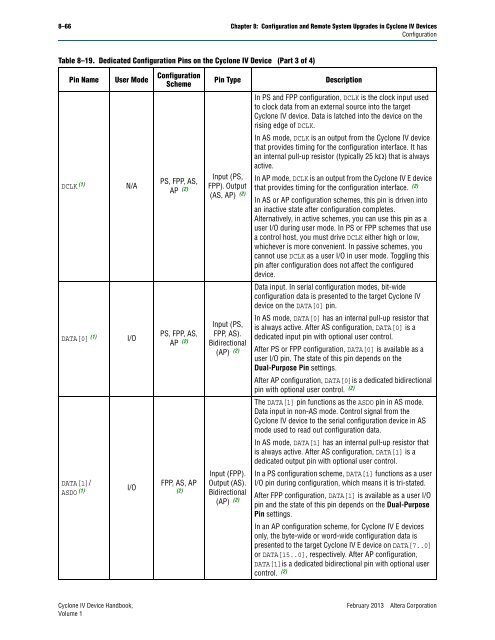Configuration and Remote System Upgrades in Cyclone IV ... - Altera
Configuration and Remote System Upgrades in Cyclone IV ... - Altera
Configuration and Remote System Upgrades in Cyclone IV ... - Altera
Create successful ePaper yourself
Turn your PDF publications into a flip-book with our unique Google optimized e-Paper software.
8–66 Chapter 8: <strong>Configuration</strong> <strong>and</strong> <strong>Remote</strong> <strong>System</strong> <strong>Upgrades</strong> <strong>in</strong> <strong>Cyclone</strong> <strong>IV</strong> Devices<br />
<strong>Configuration</strong><br />
Table 8–19. Dedicated <strong>Configuration</strong> P<strong>in</strong>s on the <strong>Cyclone</strong> <strong>IV</strong> Device (Part 3 of 4)<br />
P<strong>in</strong> Name User Mode<br />
DCLK (1) N/A<br />
DATA[0] (1) I/O<br />
DATA[1]/<br />
ASDO (1)<br />
I/O<br />
<strong>Configuration</strong><br />
Scheme<br />
PS, FPP, AS,<br />
AP (2)<br />
PS, FPP, AS,<br />
AP (2)<br />
FPP, AS, AP<br />
(2)<br />
P<strong>in</strong> Type Description<br />
Input (PS,<br />
FPP). Output<br />
(AS, AP) (2)<br />
Input (PS,<br />
FPP, AS).<br />
Bidirectional<br />
(AP) (2)<br />
Input (FPP).<br />
Output (AS).<br />
Bidirectional<br />
(AP) (2)<br />
In PS <strong>and</strong> FPP configuration, DCLK is the clock <strong>in</strong>put used<br />
to clock data from an external source <strong>in</strong>to the target<br />
<strong>Cyclone</strong> <strong>IV</strong> device. Data is latched <strong>in</strong>to the device on the<br />
ris<strong>in</strong>g edge of DCLK.<br />
In AS mode, DCLK is an output from the <strong>Cyclone</strong> <strong>IV</strong> device<br />
that provides tim<strong>in</strong>g for the configuration <strong>in</strong>terface. It has<br />
an <strong>in</strong>ternal pull-up resistor (typically 25 k) that is always<br />
active.<br />
In AP mode, DCLK is an output from the <strong>Cyclone</strong> <strong>IV</strong> E device<br />
that provides tim<strong>in</strong>g for the configuration <strong>in</strong>terface. (2)<br />
In AS or AP configuration schemes, this p<strong>in</strong> is driven <strong>in</strong>to<br />
an <strong>in</strong>active state after configuration completes.<br />
Alternatively, <strong>in</strong> active schemes, you can use this p<strong>in</strong> as a<br />
user I/O dur<strong>in</strong>g user mode. In PS or FPP schemes that use<br />
a control host, you must drive DCLK either high or low,<br />
whichever is more convenient. In passive schemes, you<br />
cannot use DCLK as a user I/O <strong>in</strong> user mode. Toggl<strong>in</strong>g this<br />
p<strong>in</strong> after configuration does not affect the configured<br />
device.<br />
Data <strong>in</strong>put. In serial configuration modes, bit-wide<br />
configuration data is presented to the target <strong>Cyclone</strong> <strong>IV</strong><br />
device on the DATA[0] p<strong>in</strong>.<br />
In AS mode, DATA[0] has an <strong>in</strong>ternal pull-up resistor that<br />
is always active. After AS configuration, DATA[0] is a<br />
dedicated <strong>in</strong>put p<strong>in</strong> with optional user control.<br />
After PS or FPP configuration, DATA[0] is available as a<br />
user I/O p<strong>in</strong>. The state of this p<strong>in</strong> depends on the<br />
Dual-Purpose P<strong>in</strong> sett<strong>in</strong>gs.<br />
After AP configuration, DATA[0]is a dedicated bidirectional<br />
p<strong>in</strong> with optional user control. (2)<br />
The DATA[1] p<strong>in</strong> functions as the ASDO p<strong>in</strong> <strong>in</strong> AS mode.<br />
Data <strong>in</strong>put <strong>in</strong> non-AS mode. Control signal from the<br />
<strong>Cyclone</strong> <strong>IV</strong> device to the serial configuration device <strong>in</strong> AS<br />
mode used to read out configuration data.<br />
In AS mode, DATA[1] has an <strong>in</strong>ternal pull-up resistor that<br />
is always active. After AS configuration, DATA[1] is a<br />
dedicated output p<strong>in</strong> with optional user control.<br />
In a PS configuration scheme, DATA[1] functions as a user<br />
I/O p<strong>in</strong> dur<strong>in</strong>g configuration, which means it is tri-stated.<br />
After FPP configuration, DATA[1] is available as a user I/O<br />
p<strong>in</strong> <strong>and</strong> the state of this p<strong>in</strong> depends on the Dual-Purpose<br />
P<strong>in</strong> sett<strong>in</strong>gs.<br />
In an AP configuration scheme, for <strong>Cyclone</strong> <strong>IV</strong> E devices<br />
only, the byte-wide or word-wide configuration data is<br />
presented to the target <strong>Cyclone</strong> <strong>IV</strong> E device on DATA[7..0]<br />
or DATA[15..0], respectively. After AP configuration,<br />
DATA[1]is a dedicated bidirectional p<strong>in</strong> with optional user<br />
control. (2)<br />
<strong>Cyclone</strong> <strong>IV</strong> Device H<strong>and</strong>book, February 2013 <strong>Altera</strong> Corporation<br />
Volume 1
















